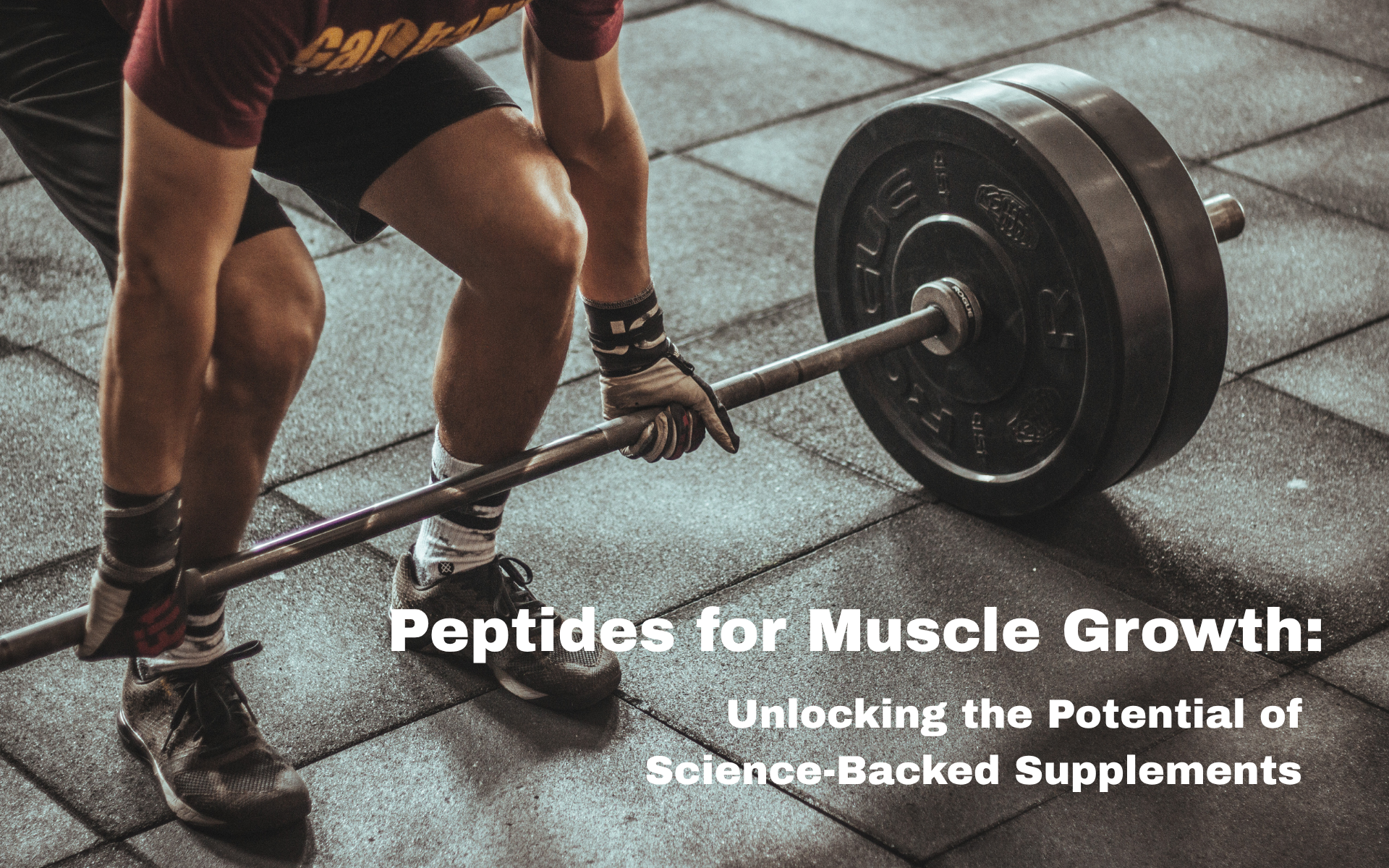Peptides for Muscle Growth: Science, Benefits & Risks

Peptides for Muscle Growth: Unlocking the Potential of Science-Backed Supplements
Introduction
Building muscle mass is a common goal for athletes, bodybuilders, and fitness enthusiasts. Achieving muscle hypertrophy—an increase in the size of muscle fibers—requires not just regular exercise and proper nutrition, but also a support system that enhances muscle growth and recovery. While protein-rich foods and workout regimens have long been the foundation for muscle-building, peptides have recently emerged as a game-changer in the world of fitness.
Peptides, short chains of amino acids that are the building blocks of proteins, play a crucial role in stimulating muscle growth, repair, and recovery. With their ability to accelerate muscle protein synthesis (MPS) and stimulate growth hormone (GH) release, peptides offer targeted solutions for muscle building. In this blog, we will explore the science behind peptides for muscle growth, their mechanisms of action, the most effective peptides, potential side effects, and their role in muscle recovery.
What Are Peptides?
Definition and Classification
Peptides are composed of short chains of amino acids—generally between two to 50 amino acids long—joined by peptide bonds. While proteins are longer chains of amino acids, peptides are much smaller and more versatile, often able to enter cells more easily, which makes them effective at delivering their biological functions quickly and efficiently.
Peptides can occur naturally in the body, acting as hormones, enzymes, and neurotransmitters. For instance, insulin and oxytocin are both peptides that have profound effects on the human body, regulating processes like glucose metabolism and social bonding. Beyond naturally occurring peptides, many others are synthetically produced in laboratories to enhance or mimic specific biological activities, including those aimed at improving muscle growth.
Scientific Mechanisms of Muscle Growth

Muscle Protein Synthesis (MPS) and Hypertrophy
Muscle growth is driven by muscle protein synthesis (MPS)—the process through which new proteins are produced to replace damaged or broken-down proteins after strenuous exercise. After resistance training, MPS is activated, leading to muscle tissue repair and the development of new muscle fibers.
To maximize muscle growth, it is essential to keep the rate of MPS higher than the rate at which muscle proteins are broken down. This process is called muscle hypertrophy, and it can be influenced by several factors, including exercise intensity, diet, and recovery. Peptides play a pivotal role in this process by stimulating the release of growth hormones and other anabolic (muscle-building) agents.
The Role of Growth Hormone and IGF-1
Two key hormones in the muscle-building process are Growth Hormone (GH) and Insulin-like Growth Factor 1 (IGF-1). GH, produced by the pituitary gland, is responsible for muscle repair, tissue regeneration, and the regulation of protein synthesis. In response to GH release, the liver produces IGF-1, a protein that directly impacts muscle growth. IGF-1 promotes protein synthesis, aids in cell proliferation, and activates satellite cells, which are responsible for regenerating muscle fibers.
Peptides that stimulate GH and IGF-1 release can significantly enhance muscle growth and recovery by boosting protein synthesis and facilitating the repair of muscle tissue. Some peptides, such as CJC-1295 and Ipamorelin, directly stimulate the release of these critical hormones.
Key Peptides for Muscle Growth
| Peptide | Mechanism | Reported Benefits | Common Side Effects |
| CJC-1295 | Stimulates GH release via GHRH receptor activation | Increased muscle hypertrophy, fat loss, better sleep | Water retention, fatigue, injection reactions |
| Ipamorelin | Selective GH secretagogue, stimulates GH without raising cortisol | Lean muscle gain, accelerated fat loss, enhanced recovery | Increased hunger, fatigue, injection reactions |
| MK-677 | Mimics ghrelin to stimulate GH and IGF-1 release | Muscle mass gain, strength improvement, better sleep | Appetite increase, water retention, insulin resistance |
| IGF-1 LR3 | Directly binds to IGF-1 receptors on muscle cells | Muscle hyperplasia, better recovery, fat loss | Joint pain, water retention, insulin resistance |
| BPC-157 | Stimulates angiogenesis, promotes healing in muscle tissue | Accelerated muscle and tendon recovery, reduced inflammation | Injection site reactions, gastrointestinal issues |
Peptides like CJC-1295, Ipamorelin, MK-677, IGF-1 LR3, and BPC-157 are increasingly popular for enhancing muscle growth and recovery. CJC-1295 and Ipamorelin stimulate the release of growth hormone (GH), boosting muscle hypertrophy and fat loss. MK-677, an oral GH secretagogue, promotes muscle gain and improves bone density. IGF-1 LR3 directly stimulates muscle cells, enhancing protein synthesis and muscle fiber development. BPC-157 accelerates healing, reducing inflammation and supporting tendon and joint health. While these peptides offer powerful benefits, they may cause side effects such as water retention, fatigue, and potential insulin resistance, making it important to use them under professional supervision.
How Peptides Enhance Muscle Recovery
Peptides not only support muscle growth but also play a critical role in muscle recovery. After intense physical exertion, muscles undergo microtears that need to be repaired in order to grow. Peptides, by enhancing nutrient delivery to muscle tissues, promoting cellular repair, and reducing inflammation, help speed up recovery times and improve overall training capacity.
By stimulating the release of GH and enhancing protein synthesis, peptides facilitate quicker healing, allowing athletes and fitness enthusiasts to train harder and more frequently, achieving faster progress toward their goals. Peptides like BPC-157 are especially beneficial for athletes suffering from tendon or ligament injuries, as they accelerate tissue regeneration and promote quicker recovery.
Peptide Safety and Side Effects
While peptides offer numerous benefits for muscle growth and recovery, they are not without potential risks. Many peptides, especially those that stimulate GH release, can have side effects, particularly when used improperly or without proper medical guidance. Common side effects of peptide use include:
- Water retention: Peptides that increase GH levels may cause the body to retain water, leading to bloating.
- Injection site reactions: For injectable peptides, redness, swelling, or irritation at the injection site is common.
- Increased hunger: Some peptides, such as MK-677, can increase appetite, which may not be ideal for those looking to maintain a lean physique.
- Fatigue: A common side effect of peptides like CJC-1295, especially in the early stages of use.
- Hormonal imbalances: Long-term use of peptides that affect GH and IGF-1 levels could potentially lead to insulin resistance or other metabolic disturbances.
More significant risks arise from the prolonged or unsupervised use of these compounds. Elevated GH and IGF-1 levels may lead to insulin resistance, increased blood sugar, and even organ enlargement if used in excess.
FAQs
1. Are peptides safe for muscle growth?
Peptides can be effective for muscle growth, but their safety is not guaranteed, particularly for long-term use. Many peptides are not FDA-approved, and their long-term effects in healthy individuals are not fully understood. Always consult with a healthcare provider before using peptides for muscle growth.
2. How long does it take for peptides to show results?
Results from peptide use can vary depending on the peptide, dosage, and individual factors such as diet and exercise. Typically, users may begin to see visible results within 4 to 6 weeks, though significant changes may take 2 to 3 months of consistent use.
3. Can peptides be used with other supplements?
Yes, peptides can be combined with other muscle-building supplements like creatine, protein powders, or amino acids. However, it’s important to be cautious and ensure that combinations do not lead to adverse effects or interactions.
4. Are peptides banned in sports?
Many peptides are banned by the World Anti-Doping Agency (WADA) for their performance-enhancing effects. Athletes should ensure that any peptide they use complies with WADA regulations.
Conclusion
Peptides represent a cutting-edge solution for enhancing muscle growth, recovery, and performance. With the ability to stimulate growth hormone release, enhance protein synthesis, and promote tissue repair, peptides provide a targeted approach to muscle development. However, the potential risks, including hormonal imbalances and long-term health concerns, must not be overlooked. It is essential to use peptides responsibly, under professional supervision, and with a clear understanding of the potential side effects.
As research continues to evolve, peptides like CJC-1295, Ipamorelin, MK-677, IGF-1 LR3, and BPC-157 offer exciting opportunities for individuals looking to maximize their muscle growth potential. However, it is crucial to remember that peptides should be seen as a supplement to a well-rounded fitness regimen that includes proper nutrition, exercise, and recovery.
Disclaimer:
While peptides show promise in enhancing muscle growth, their use should be approached with caution. The safety and long-term effects of many peptides, especially when used outside medical supervision, remain uncertain. Always consult with a healthcare provider before using peptides or any other supplements.
Want to learn more about peptides and how they can help optimize your muscle growth and recovery? Visit PeptideWebMD for expert advice, product recommendations, and guidelines on safe peptide use. Begin your journey toward better performance today!

